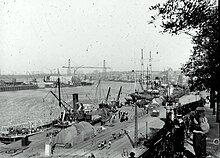Nantes transporter bridge
Coordinates: 47 ° 12 '30 " N , 1 ° 33' 58" W.
| Nantes transporter bridge | ||
|---|---|---|
| The transporter bridge before 1914 | ||
| Crossing of | Loire | |
| place | Nantes | |
| construction | Transporter bridge | |
| Longest span | 141 m | |
| start of building | February 16, 1902 | |
| opening | November 1, 1903 | |
| Status | tore off | |
| planner | Ferdinand Arnodin | |
| closure | January 1, 1955 | |
| location | ||
|
|
||
The Nantes transporter bridge (1903–1958) is a former bridge over the Loire in Nantes . Designed by the engineer these Ferdinand Arnodin built transporter bridge allowed the crossing of an arm of the Loire, the Bras de la Madeleine , in the amount of today's bridge Pont Anne-de-Bretagne and joined the Quai de la Fosse with the Prairie au Duc .
history
Context and projects
At the end of the 19th century, the development of shipyards and the cutting created by the Loire created problems with the transport of workers and goods between the two banks. A swing bridge didn't make sense because of the vagaries of the river. A tunnel was considered, but the sandy and stony subsoil proved to be unfavorable. The possibility of a permanent bridge was also discarded, as the sailing ships, which were still numerous at the time, required a large clearance and the resulting long access ramps would have required the demolition of numerous buildings. Finally, the invention of the transporter ferry with the construction of the Puente de Vizcaya at the entrance to the port of Bilbao in Spain between 1888 and 1893 provided the solution. And so they called Ferdinand Arnodin, who had built the Spanish transporter bridge together with Alberto Palacio .
concession
By ordinance of May 26, 1898, the public benefit was established and the construction of a transporter ferry in the port of Nantes was approved. The contract for the construction and the operating rights for 80 years were given to Eiffel's pupil Ferdinand Arnodin.
Construction (1902–1903)
Work began on February 16, 1902 with the excavation of the construction pits. The steel parts of the bridge girder and the pylons were made in Châteauneuf, where the Arnodin workshops were located. The installation of a crane at the construction site enabled the assembly of the pylons to begin at the end of August.
In November 1902 the pylon on the right bank was completed, in February 1903 the one on the left bank as well. The assembly of the bridge girder and the counterweights took place in three steps: first of all, the bridge girders were mounted on each of the banks and finally the 46 t middle section was raised on August 3, 1903 at 6 p.m. and placed 50 m above the river in its final position. After the nacelle had been installed, a load test was carried out with 85 t of stones.
Inauguration and operation
The bridge was inaugurated and put into operation on November 1, 1903 at 7 a.m. There was a great rush; the success of the first day was estimated at 10,000 crossings at 5 or 6 centimes , depending on the class, and two thousand climbs at the rate of 0.50 francs . For the two-minute crossing, chips had to be bought beforehand .
demolition
After more than 51 years of operation, the transporter bridge was decommissioned on January 1, 1955. Despite protests, it was dismantled and scrapped in 1958. Even today it has great symbolic value for the residents of Nantes. This was proven in 1982 by the 1953 film A Room in the City in Nantes , in which the director Jacques Demy and the set designer Bernard Evein used matte painting to make the transporter appear during the opening credits. Demy was especially proud of that attitude.
properties
The two 75 m high pylons and the steel bridge girder 50 m above the quay are characteristic. A gondola, which was suspended on cables from the bridge girder, provided the transfer from one bank to the other. This sidewalk-lined platform carried benches and a first-class cabin over which the glazed operator's platform was located. This transporter bridge was one of the cantilever bridges that were guyed with stay cables and kept in balance by means of a counterweight and anchoring, like the transporter bridge in Marseille . This avoids the inconvenience that the usual anchoring of suspension bridges within the city brings with it at a greater distance, as can still be seen today on the suspension ferries from Rochefort , Bilbao or Newport .
Remains of the transporter bridge
The foundations of the former steel structures can still be seen today on both banks. At the northwest corner of the Pont Anne-de-Bretagne , which today takes the place of the transporter bridge, a commemorative plaque is attached to the railing.
See also
literature
- Jean-Paul Bouyer: Vie et mort d'un transbordeur . Pierre Gauthier, 1989.
- Jacques Sigot: Nantes: le Transbordeur . Editions CMD, 1996, ISBN 978-2-909826-40-0 .
Web links
- Ferdinand Arnodin and the suspension ferries on postcards and stamps (French, many pictures)
- Nantes transporter bridge. In: Structurae
Individual evidence
- ↑ a b c d Le pont-transbordeur ( fr ) Conseil général Loire-Atlantique. Retrieved July 21, 2010.
- ↑ a b c Pascale Wester: Le Transbordeur aurait 100 ans ( fr , PDF; 2.5 MB) In: Nantes au quotidien, supplément à Nantes Passion, magazine de l'information municipale n ° 137 . Archives municipales de Nantes. Pp. 29-31. 2003. Retrieved July 21, 2010.
- ↑ Jean-Pierre Berthomé: Jacques Demy et les racines du rêve . L'Atalante, 1996, ISBN 2-84172-042-X .






